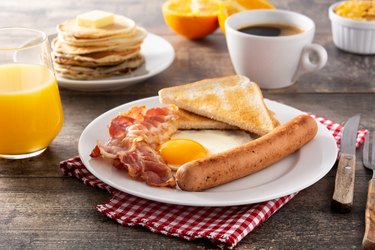
Your body can't immediately transform bites of food into fuel. That's where the digestion process comes in — through it, your body decreases the size of food particles, according to Johns Hopkins Medicine.
These smaller molecules of food particles can then be absorbed into your body, passing from your digestive system into your bloodstream, per the National Cancer Institute. That allows your body to benefit from the nutrients the food contains.
Video of the Day
Video of the Day
The GI system is sophisticated, and the process for breaking down different food groups varies — here, a look at what happens when you take in proteins and fats.
Related Reading
Protein Digestion and Absorption
For all food groups, the digestion process kicks off in your mouth, where you chew and swallow food, allowing it to make its way to your stomach, per the Cleveland Clinic.
Protein takes longer to break down than carbohydrates, according to University Hospitals, and fats take the longest amount of time.
Once food proteins hit your stomach's acidic environment, pepsin (a digestive enzyme) breaks it down into small pieces called peptides, per the Medicine Library. These peptides travel to your small intestine, where different digestive enzymes — secreted from your pancreas — break them down into even smaller molecules.
The digestion process has made the protein small enough to be absorbed through the cells lining the small intestines into capillaries, per the National Cancer Institutes — that is, these molecules can now move through your body via your bloodstream.
Related Reading
Fat Digestion and Absorption
Fat is an essential nutrient (yes, even if you're trying to lose weight), helping your body function and providing energy. Adults should get 25 to 35 percent of their calories from fat, according to the 2015-2020 Dietary Guidelines for Americans.
Most of the fat you consume are triglycerides, a type of lipid, per the Cleveland Clinic. Lipids are digested in the mouth, stomach and small intestine.
Food Sources of Triglycerides
Both saturated and unsaturated fats are triglycerides. But as you likely know, these two types of fat have very different health implications:
- Unsaturated fats: Monounsaturated and polyunsaturated fats are liquid at room temperature, and considered good for you, per the Harvard T.H. Chan School of Public Health. Foods such as olive oil, avocados, nuts and fatty fish contain unsaturated fats.
- Saturated fats: These fats are solid at room temperature, like butter. They’re found mainly in animal foods (think: bacon and whole milk), according to the Harvard T.H. Chan School of Public Health. Experts recommend limiting your consumption of unsaturated fat.
These two types of fats have a different structure. A triglyceride is made up of a glycerol backbone with three fatty acids attached, according to the Linus Pauling Institute. The fatty acid chains attached to the backbone of triglycerides in saturated fats are single bonded, while the fatty acid chains in unsaturated fats contain double bonds, per the Institute.
What Digests Fat?
To get what it needs out of the triglycerides from the food you eat, your body must go through a two-step digestive process that includes emulsification and enzyme digestion.
Emulsification is necessary because triglycerides are insoluble, meaning they cannot mix with water. So, in order to digest the triglycerides in food, they must be emulsified (aka dispersed in another liquid). That's done through bile acids, which are made in the liver, according to the International Foundation for Gastrointestinal Disorders (IFFGD).
This emulsification process makes the triglycerides more accessible to digestive enzymes, which help to break it down into fatty acids and monoglycerides, per the Medicine Library.
With help again from bile, these fatty acids and monoglycerides come together to form micelles, which are absorbed through your small intestines and enter the cells, according to the Medicine Library.
Absorbing Fat
Your body's absorption of fat differs from protein absorption, and is a bit more complicated.
In order to travel through the bloodstream, the fatty acids and monoglycerides recombine — these newly reformed triglycerides then join up with other lipids to form a transporter package called a chylomicron, per Human Nutrition, an open-access textbook.
These chylomicrons pass into lymphatic vessels, then enter your bloodstream. Once the chylomicrons reach your blood, they disassemble and their contents move throughout your body.
So, to review: Your body takes triglycerides, breaks them down and then reforms them. After that, these newly reformed triglycerides combine with other lipids, then are separated out again.
Along with coming straight from fatty foods (think: butter and oil), excess calories are turned into triglycerides and stored in fat cells for later use, per the National Library of Medicine.
While fat is an essential nutrient, high levels of triglycerides are a health concern, increasing your risk of heart disease, according to the Cleveland Clinic. A diet low in fats, sugars and simple carbs helps lower triglycerides, per the Cleveland Clinic.
- Johns Hopkins Medicine: "How Digestion Works"
- National Cancer Institute: "Introduction to the Digestive System"
- Cleveland Clinic: "How Long Does It Take to Digest Food"
- University Hospitals: "The Digestive Process: How Is Food Digested in the Stomach?"
- Medicine Library: "5.4: Protein Digestion, Absorption and Metabolism"
- USDA: "2015-2020 Dietary Guidelines for Americans"
- Cleveland Clinic: "Triglycerides"
- Harvard T.H. Chan School of Public Health: "Types of Fat"
- Linus Pauling Institute: "High Triglycerides"
- International Foundation for Gastrointestinal Disorders: "The Digestive System"
- Medicine Library: "5.4: Digestion and Absorption of Lipids"
- Human Nutrition: "Digestion and Absorption of Lipids"
- National Library of Medicine: "Triglycerides"
- Cleveland Clinic: "Triglycerides & Heart Health"